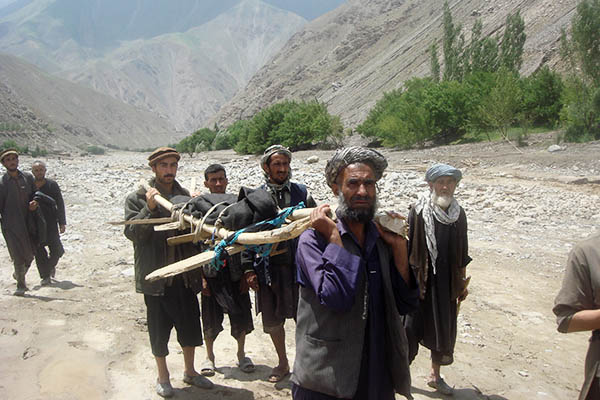Rescuers in Baghlan province rush to provide aid to affected families as local lawmaker warns of further casualties.
Rescuers scrambled Sunday to deliver food and medical supplies to Afghan families marooned on mountaintops after flash floods killed 74 people in a remote northern district, washing away hundreds of homes and forcing thousands to flee. The death toll was expected to rise, with scores of people said to be missing in the mountainous district of Baghlan province after torrential rains unleashed the floods on Friday.
The floods come a month after a landslide triggered by heavy rains buried a village and killed 300 people in a nearby region. The twin disasters highlight the challenges facing underdeveloped Afghanistan’s next leader as the country heads into the second round of the presidential election on June 14.
“People have lost everything they had—houses, property, villages, agricultural fields, cattle,” Baghlan police spokesman Jawed Basharat said about the floods. “There’s nothing left for them to survive. People don’t even having drinking water,” he added. “They urgently need water, food items, blankets and tents.”
Television channels relayed footage of one man wading through a gushing stream of muddy brown flood waters, his back stooped under the weight of a burlap sack.
Basharat said the Afghan army was battling to deliver aid to the affected families, many of who have fled to mountaintops to escape flood waters.
Afghanistan’s defense ministry had dispatched two helicopters to deliver aid packages to the area as roads and mountain passes were left devastated by the floods, said Obaidullah Ramin, an M.P. from Baghlan province. “Some nine kilometers of roads were destroyed by floodwaters, so officials are trying to deliver aid by air,” said Ramin. “Relief agencies have distributed some aid, but it is not enough. The problems of the flood-affected people need to be addressed fully,” he said, adding that he had toured the affected areas.
Most disaster management officials were difficult to reach Sunday due to poor telecommunication networks in the remote area. The governor of the province, Sultan Mohammad Ebadi, said the death toll stood at 74, warning that the extent of the disaster was “massive” and that the toll was expected to rise further.
Bodies of women and children were among those recovered from the inundated areas, the National Disaster Management Authority (NDMA) said, adding that scores of people were missing.
“There is a lot of stagnant water, and there are more bodies under the rubble and mud,” said Mohammad Nasim Kohzad, head of NDMA in Baghlan. “We are still looking for other victims of this flood.”
The governor of the remote affected district of Guzargah-e-Nur confirmed that 74 bodies had been recovered by authorities. “The floods destroyed four villages, and washed away 2,000 residential houses, agricultural fields and also killed thousands of cattle,” said Noor Mohammad Guzar.
Officials were further assessing the extent of the damage on life and property in the affected area, Mohammad Aslam Sayas, the deputy head of the National Disaster Management Authority, said. “Our teams have also provided some edibles and medication to the affected people. More aid will get there soon,” he said.
Outgoing Afghan President Hamid Karzai in a statement said he was saddened by the loss of life and property in Baghlan province, and directed disaster management officials to dispatch emergency relief aid to affected families.
Last month a landslide triggered by heavy rains buried a village in a remote area of northeast Badakhshan province, killing at least 300 people. The May 2 disaster left hundreds of families homeless in Argu district of the mountainous province, which borders Tajikistan, China and Pakistan.
The floods and landslides follow recent severe flooding that has affected a vast swathe of Afghanistan, particularly northern provinces, leaving 175 people dead and tens of thousands displaced. Flooding and landslides often occur during the spring rainy season in northern Afghanistan, with flimsy mud houses offering little protection against rising water levels and torrents of mud.

